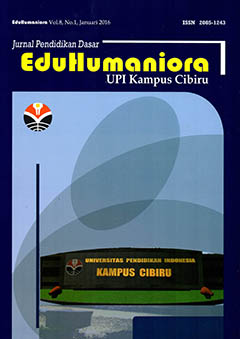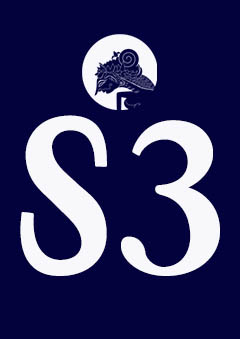Online Submissions
Already have a Username/Password for EduHumaniora | Jurnal Pendidikan Dasar Kampus Cibiru?
Go to Login
Need a Username/Password?
Go to Registration
Registration and login are required to submit items online and to check the status of current submissions.
Author Guidelines
- Articles submitted to the Journal should normally be between 4,000 to 6,000 words or maximum 20 pages with single space and should be accompanied by an abstract of not more than 200 words, containing the importance of the topic, the gap between theory and practice or between reality and expectation, or lacks of studies, objectives of the present study, method, findings, and conclusion.
- On the abstract, explicitly write in bold: Introduction, objective of the papers, method, findings, and conclusion.
- Below the abstract, about three to five keywords should appear together with the main body of the article with the font size 11.
- The Journal operates a peer review process and promotes blind reviewing. To facilitate this process, author’s names (without academic titles), institutional affiliations, and the email address of the corresponding author should appear only on a detachable cover sheet.
- Contributor(s) should include a short CV describing his/her/their current position and activities in not more than 80 words.
- Articles should be written in English in single space, using Microsoft Word, font size 12, Times New Roman, top and left margin 3 cm, bottom and right margin 2.54 cm, printed in A4.
- Insert a header on even page indicating name of the Journal, Volume, Number, month, and year, and page number of the publication. On odd page, insert the author(s) and a few words of the title of the articles.
- Footnotes should appear at the end of the text, not at the foot of the relevant page. Page number should be inserted at the bottom, placed on the right.
- Write the main body of the article in two columns.
- Block citation should be 1 cm indented with the font size 11.
- For research-based articles, the outline used is: introduction (without heading or subheading), method, findings and discussion, conclusion, and references.
- The title should be less than 14 words, capitalized, centered, with font size 14.
- The introduction should consist of the background of the study, research contexts, literary review, and research objective. All introduction should be presented in the forms of paragraphs, not pointers, with the proportion of 15-20% of the whole article length.
- The method section consists of description concerning the research design, data sources, data collection, and data analysis with the proportion of 10-15% of the total article length, all presented in the form of paragraphs.
- The findings and discussion section consist of description of the results of the data analysis to answer the research question(s) and their meanings seen from current theories and references of the area addressed. The proportion of this section is 40-60% of the total article length.
- The conclusion section consists of the summary, restatement of the main findings.
- Use only horizontal lines when using tables. Put table number and the title of the table on top of it.
- Every source cited in the body of the article should appear in the reference, and all sources appearing in the reference should be cited in the body of the article.
- The sources cited should at least 80% come from those published in the last 10 years. The sources cited are primary sources in the forms of journal articles, books, and research reports, including theses and dissertations. Citations from journal should be at least 80% of the total references cited.Referenced library sources at least come from 20 sources.
- Citation is done using bracket (last name and year of publication). When the sources are cited verbatim, page number is included (78-79).
- Proofs will be sent to the author for correction, and should be returned to eduhumaniora@upi.edu by the deadline given.
- Quotation and references follows APA style and the latter should be included at the end of the article in the following examples:
Abidin, Y., Mulyati, T. & Yunansah, Y. (2017)Developing literacy learning model based on multi literacy, integrated, and differentiated concept at primary school. Cakrawala Pendidikan. XXXVI (2)156-166.
Cramond, B. (2007). Enriching the brain? Probably not for psychologists PsycCRITIQUES, 52(4), 100-115.
Greenleaf, C.L. et al. (2010). Integrating literacy and science in biology: teaching and learning impacts of reading apprenticeship professional development. American Educational Research Journal. 44 (1).647–717.
Janzen. J. (2009). Teaching english language learners in the content areas. Review of Educational Research. 78 (4). 1010–1038.
Kennedy, W. A. (1988). Speaking across the curriculum: teaching technical students to speak effectively. IEEE Transactions on Professional Communication. 31(3). 130-134.
Klein, S. (2013). Review multiliteracy centers: writing center work, new media, and multimodal rhetoric. The Writing Center Journal. 33 (1). 136-139.
Navehebrahim, M. (2011) Multiliteracies approach to empower learning and teaching engagement. Procedia – Social and Behavioral Sciences. 29 (2011) 863– 868.
Palmer, R. (2020). A third way: online labs integrated with print materials. Indonesian Journal of Applied Linguistics.2(2) 110-120.
Shyyan, V., Thurlow, M.L., and Liu, K.K. (2008). Instructional strategies for improving achievement in reading, mathematics, and science for english language learners with disabilities. Assessment for Effective Intervention. 33 (3). 145–155.
Sklair, L. (2010). Iconic Architecture and the Culture-ideology of Consumerism. Theory Culture Society, 27(135),135-159.
Sukyadi, D. & Mardiani, R. (2011). The washback effect of national examination (ENE) on English teachers’ classroom teaching and students’ learning. K@ta: A Biannual Publication on the Study of Language and Literature, 13(1), 96-111.
Tan, M. 2011. Mathematics and science teachers’ beliefs and practices regarding the teaching of language in content learning. Language Teaching Research. 15 (3). 325–342.
EDUHUMANIORA TEMPLATE
PANDUAN PENGGUNAAN EJOURNAL UPI BAGI PENULIS
Submission Preparation Checklist
As part of the submission process, authors are required to check off their submission's compliance with all of the following items, and submissions may be returned to authors that do not adhere to these guidelines.
- The submission has not been previously published, nor is it before another journal for consideration (or an explanation has been provided in Comments to the Editor).
- The submission file is in OpenOffice, Microsoft Word, RTF, or WordPerfect document file format.
- Where available, URLs for the references have been provided.
- The text is single-spaced; uses a 12-point font; employs italics, rather than underlining (except with URL addresses); and all illustrations, figures, and tables are placed within the text at the appropriate points, rather than at the end.
- The text adheres to the stylistic and bibliographic requirements outlined in the Author Guidelines, which is found in About the Journal.
- If submitting to a peer-reviewed section of the journal, the instructions in Ensuring a Blind Review have been followed.
Copyright Notice
Authors who publish with this journal agree to the following terms:
(1) Copyright of the published articles will be transferred to the journal as the publisher of the manuscripts. Therefore, the author confirms that the copyright has been managed by the publisher.
(2) Publisher of Eduhumaniora: Jurnal Pendidikan Dasar is Program Studi PGSD UPI Kampus Cibiru, Universitas Pendidikan Indonesia (UPI).
(3) The copyright follows Creative Commons Attribution–ShareAlike License (CC BY SA): This license allows to Share — copy and redistribute the material in any medium or format, Adapt — remix, transform, and build upon the material, for any purpose, even commercially.
Privacy Statement
The names and email addresses entered in this journal site will be used exclusively for the stated purposes of this journal and will not be made available for any other purpose or to any other party.
Author Fees
This journal charges the following author fees.
Article Publication: 750000.00 (IDR)
To develop our indexation and Journal Systems when the manuscript is editorially accepted, author(s) asked to give donation to help journal as much as IDR 750.000 (USD500). Please note that the payment is non-refundable.
If you do not have funds to pay such fees, you will have an opportunity to waive each fee. The waiver of publishing fees can be done completely by contacting the editorial board. We do not want fees to prevent the publication of worthy work.















